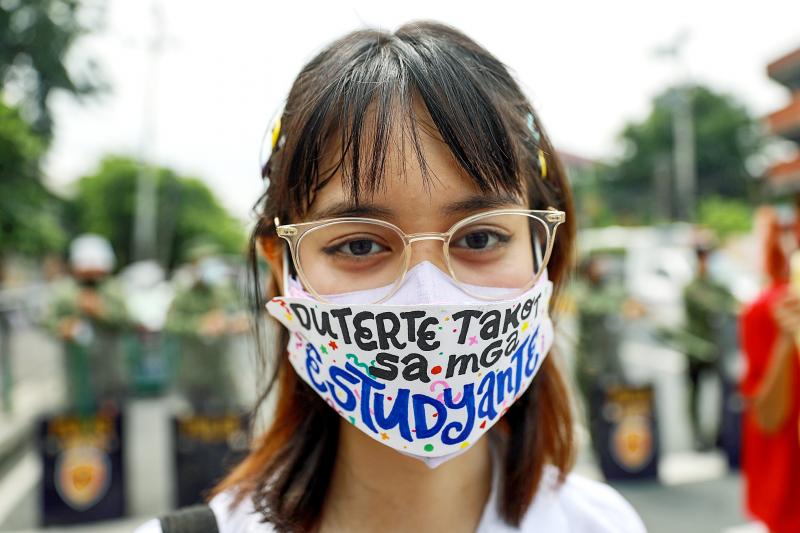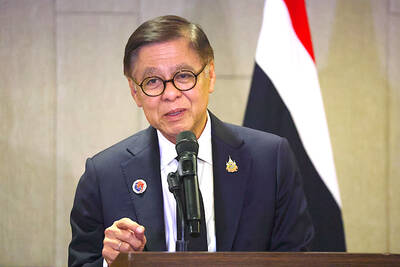Classrooms in the Philippines were silent yesterday as millions of school children hunkered down at home for a second year of remote lessons that experts fear could worsen an educational “crisis.”
While nearly every country in the world has partially or fully reopened schools for in-person classes, the Philippines has kept them closed since the start of the COVID-19 pandemic, the UN says.
Philippine President Rodrigo Duterte has so far rejected proposals for a pilot reopening of primary and secondary schools for fear that children could catch COVID-19 and infect elderly relatives.

Photo: EPA-EFE
“I want to go to school,” seven-year-old Kylie Larrobis said, adding that she cannot read after a year of online kindergarten in the tiny slum apartment in Manila she shares with six people.
“I don’t know what a classroom looks like — I’ve never seen one,” she said.
Larrobis, who enters Grade 1 this year, cries in frustration when she cannot understand her online lessons, which she follows on a smartphone, said her mother, Jessielyn Genel.
Her misery is compounded by a ban on children playing outdoors.
“What is happening is not good,” said Genel, who opposes a return to in-person classes while the Delta variant of SARS-CoV-2 rips through the country.
A “blended learning” program involving online classes, printed materials and lessons broadcast on TV and social media was launched in October last year.
It has been plagued with problems: Most students in the Philippines do not have a computer or Internet at home.
More than 80 percent of parents are worried their children “are learning less,” UN Children’s Fund education chief in the Philippines Isy Faingold said, citing a recent survey.
About two-thirds of them support the reopening of classrooms in areas where virus transmission is low.
“Distance learning cannot replace the in-person learning,” Faingold said. “There was already a learning crisis before COVID ... it’s going to be even worse.”
Most students attend public schools where large class sizes, outdated teaching methods, lack of investment in basic infrastructure and poverty have been blamed for youngsters lagging behind.
School enrollments fell to 26.9 million in September last year and have dropped a further 5 million since, official figures showed.
Faingold said that many students might “never return.”
“We hope in the next days the enrollments continue to accelerate,” Faingold said.
Remote learning is also taking a toll on children’s mental health and development.
“Long-term social isolation is closely related to loneliness and physiological illness in children,” said Rhodora Concepcion of the Philippine Society for Child and Adolescent Psychiatry.
“With the disruption of face-to-face learning and social interaction, regression in formerly mastered skills may be observed in children,” she said.
Petronilo Pacayra is worried about his sons, aged nine and 10.
“Their reading skills really deteriorated,” the 64-year-old single parent said in a cramped and dimly-lit room they share.
Pacayra helps them with their school work in between doing odd jobs to make ends meet.
“I don’t like reading, I prefer to play with my mobile phone,” said his youngest child, nicknamed RJ, who is starting Grade 2.
Their school principal Josefina Almarez said that “no children were left behind” in the first year of remote learning.
However, she said some “need special attention.”
Younger children are especially affected by school closures, Faingold said, describing the early years of schooling as “foundational.”
“If you don’t have a strong basis in numeracy and literacy it’s going to be very difficult to learn the other subjects that are part of the primary, secondary or even tertiary education,” he said.
Mercedes Arzadon, a professor of education at the University of the Philippines, said it was “ridiculous” to keep schools shut indefinitely when other countries, including virus-ravaged Indonesia, had shown it was possible to reopen them safely.
“Our youths’ future and well-being are at stake, and so is national development,” Arzadon said in a statement.

The death of a former head of China’s one-child policy has been met not by tributes, but by castigation of the abandoned policy on social media this week. State media praised Peng Peiyun (彭珮雲), former head of China’s National Family Planning Commission from 1988 to 1998, as “an outstanding leader” in her work related to women and children. The reaction on Chinese social media to Peng’s death in Beijing on Sunday, just shy of her 96th birthday, was less positive. “Those children who were lost, naked, are waiting for you over there” in the afterlife, one person posted on China’s Sina Weibo platform. China’s

‘POLITICAL LOYALTY’: The move breaks with decades of precedent among US administrations, which have tended to leave career ambassadors in their posts US President Donald Trump’s administration has ordered dozens of US ambassadors to step down, people familiar with the matter said, a precedent-breaking recall that would leave embassies abroad without US Senate-confirmed leadership. The envoys, career diplomats who were almost all named to their jobs under former US president Joe Biden, were told over the phone in the past few days they needed to depart in the next few weeks, the people said. They would not be fired, but finding new roles would be a challenge given that many are far along in their careers and opportunities for senior diplomats can

Australian Prime Minister Anthony Albanese yesterday announced plans for a national bravery award to recognize civilians and first responders who confronted “the worst of evil” during an anti-Semitic terror attack that left 15 dead and has cast a heavy shadow over the nation’s holiday season. Albanese said he plans to establish a special honors system for those who placed themselves in harm’s way to help during the attack on a beachside Hanukkah celebration, like Ahmed al-Ahmed, a Syrian-Australian Muslim who disarmed one of the assailants before being wounded himself. Sajid Akram, who was killed by police during the Dec. 14 attack, and

RUSHED: The US pushed for the October deal to be ready for a ceremony with Trump, but sometimes it takes time to create an agreement that can hold, a Thai official said Defense officials from Thailand and Cambodia are to meet tomorrow to discuss the possibility of resuming a ceasefire between the two countries, Thailand’s top diplomat said yesterday, as border fighting entered a third week. A ceasefire agreement in October was rushed to ensure it could be witnessed by US President Donald Trump and lacked sufficient details to ensure the deal to end the armed conflict would hold, Thai Minister of Foreign Affairs Sihasak Phuangketkeow said after an ASEAN foreign ministers’ meeting in Kuala Lumpur. The two countries agreed to hold talks using their General Border Committee, an established bilateral mechanism, with Thailand